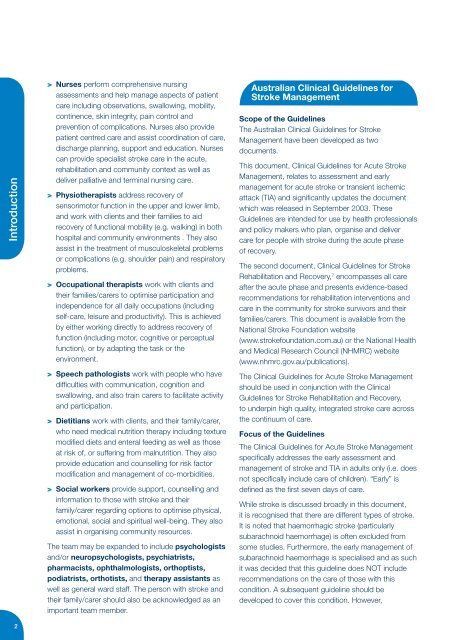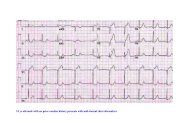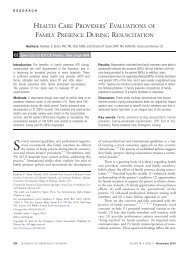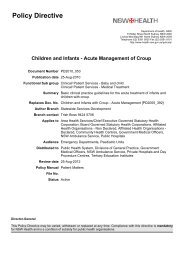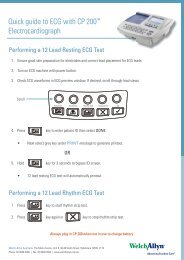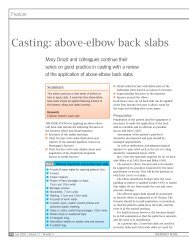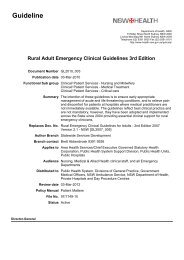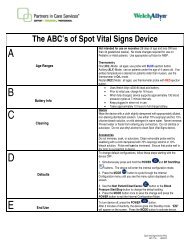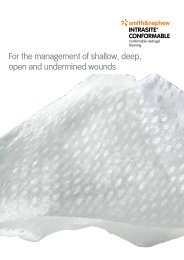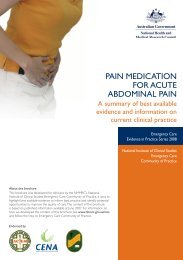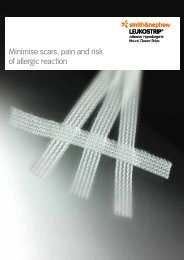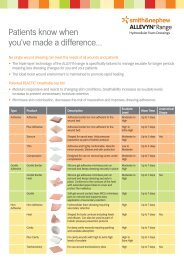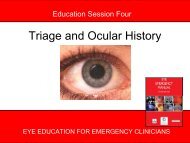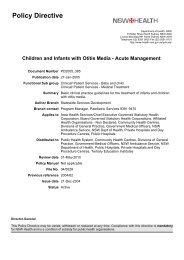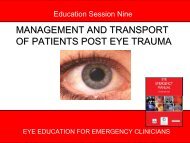Clinical Guidelines for Acute Stroke Management - Living on the EDge
Clinical Guidelines for Acute Stroke Management - Living on the EDge
Clinical Guidelines for Acute Stroke Management - Living on the EDge
Create successful ePaper yourself
Turn your PDF publications into a flip-book with our unique Google optimized e-Paper software.
2Introducti<strong>on</strong><br />
> Nurses per<str<strong>on</strong>g>for</str<strong>on</strong>g>m comprehensive nursing<br />
assessments and help manage aspects of patient<br />
care including observati<strong>on</strong>s, swallowing, mobility,<br />
c<strong>on</strong>tinence, skin integrity, pain c<strong>on</strong>trol and<br />
preventi<strong>on</strong> of complicati<strong>on</strong>s. Nurses also provide<br />
patient centred care and assist coordinati<strong>on</strong> of care,<br />
discharge planning, support and educati<strong>on</strong>. Nurses<br />
can provide specialist stroke care in <strong>the</strong> acute,<br />
rehabilitati<strong>on</strong> and community c<strong>on</strong>text as well as<br />
deliver palliative and terminal nursing care.<br />
> Physio<strong>the</strong>rapists address recovery of<br />
sensorimotor functi<strong>on</strong> in <strong>the</strong> upper and lower limb,<br />
and work with clients and <strong>the</strong>ir families to aid<br />
recovery of functi<strong>on</strong>al mobility (e.g. walking) in both<br />
hospital and community envir<strong>on</strong>ments . They also<br />
assist in <strong>the</strong> treatment of musculoskeletal problems<br />
or complicati<strong>on</strong>s (e.g. shoulder pain) and respiratory<br />
problems.<br />
> Occupati<strong>on</strong>al <strong>the</strong>rapists work with clients and<br />
<strong>the</strong>ir families/carers to optimise participati<strong>on</strong> and<br />
independence <str<strong>on</strong>g>for</str<strong>on</strong>g> all daily occupati<strong>on</strong>s (including<br />
self-care, leisure and productivity). This is achieved<br />
by ei<strong>the</strong>r working directly to address recovery of<br />
functi<strong>on</strong> (including motor, cognitive or perceptual<br />
functi<strong>on</strong>), or by adapting <strong>the</strong> task or <strong>the</strong><br />
envir<strong>on</strong>ment.<br />
> Speech pathologists work with people who have<br />
difficulties with communicati<strong>on</strong>, cogniti<strong>on</strong> and<br />
swallowing, and also train carers to facilitate activity<br />
and participati<strong>on</strong>.<br />
> Dietitians work with clients, and <strong>the</strong>ir family/carer,<br />
who need medical nutriti<strong>on</strong> <strong>the</strong>rapy including texture<br />
modified diets and enteral feeding as well as those<br />
at risk of, or suffering from malnutriti<strong>on</strong>. They also<br />
provide educati<strong>on</strong> and counselling <str<strong>on</strong>g>for</str<strong>on</strong>g> risk factor<br />
modificati<strong>on</strong> and management of co-morbidities.<br />
> Social workers provide support, counselling and<br />
in<str<strong>on</strong>g>for</str<strong>on</strong>g>mati<strong>on</strong> to those with stroke and <strong>the</strong>ir<br />
family/carer regarding opti<strong>on</strong>s to optimise physical,<br />
emoti<strong>on</strong>al, social and spiritual well-being. They also<br />
assist in organising community resources.<br />
The team may be expanded to include psychologists<br />
and/or neuropsychologists, psychiatrists,<br />
pharmacists, ophthalmologists, orthoptists,<br />
podiatrists, orthotists, and <strong>the</strong>rapy assistants as<br />
well as general ward staff. The pers<strong>on</strong> with stroke and<br />
<strong>the</strong>ir family/carer should also be acknowledged as an<br />
important team member.<br />
Australian <str<strong>on</strong>g>Clinical</str<strong>on</strong>g> <str<strong>on</strong>g>Guidelines</str<strong>on</strong>g> <str<strong>on</strong>g>for</str<strong>on</strong>g><br />
<str<strong>on</strong>g>Stroke</str<strong>on</strong>g> <str<strong>on</strong>g>Management</str<strong>on</strong>g><br />
Scope of <strong>the</strong> <str<strong>on</strong>g>Guidelines</str<strong>on</strong>g><br />
The Australian <str<strong>on</strong>g>Clinical</str<strong>on</strong>g> <str<strong>on</strong>g>Guidelines</str<strong>on</strong>g> <str<strong>on</strong>g>for</str<strong>on</strong>g> <str<strong>on</strong>g>Stroke</str<strong>on</strong>g><br />
<str<strong>on</strong>g>Management</str<strong>on</strong>g> have been developed as two<br />
documents.<br />
This document, <str<strong>on</strong>g>Clinical</str<strong>on</strong>g> <str<strong>on</strong>g>Guidelines</str<strong>on</strong>g> <str<strong>on</strong>g>for</str<strong>on</strong>g> <str<strong>on</strong>g>Acute</str<strong>on</strong>g> <str<strong>on</strong>g>Stroke</str<strong>on</strong>g><br />
<str<strong>on</strong>g>Management</str<strong>on</strong>g>, relates to assessment and early<br />
management <str<strong>on</strong>g>for</str<strong>on</strong>g> acute stroke or transient ischemic<br />
attack (TIA) and significantly updates <strong>the</strong> document<br />
which was released in September 2003. These<br />
<str<strong>on</strong>g>Guidelines</str<strong>on</strong>g> are intended <str<strong>on</strong>g>for</str<strong>on</strong>g> use by health professi<strong>on</strong>als<br />
and policy makers who plan, organise and deliver<br />
care <str<strong>on</strong>g>for</str<strong>on</strong>g> people with stroke during <strong>the</strong> acute phase<br />
of recovery.<br />
The sec<strong>on</strong>d document, <str<strong>on</strong>g>Clinical</str<strong>on</strong>g> <str<strong>on</strong>g>Guidelines</str<strong>on</strong>g> <str<strong>on</strong>g>for</str<strong>on</strong>g> <str<strong>on</strong>g>Stroke</str<strong>on</strong>g><br />
Rehabilitati<strong>on</strong> and Recovery, 7 encompasses all care<br />
after <strong>the</strong> acute phase and presents evidence-based<br />
recommendati<strong>on</strong>s <str<strong>on</strong>g>for</str<strong>on</strong>g> rehabilitati<strong>on</strong> interventi<strong>on</strong>s and<br />
care in <strong>the</strong> community <str<strong>on</strong>g>for</str<strong>on</strong>g> stroke survivors and <strong>the</strong>ir<br />
families/carers. This document is available from <strong>the</strong><br />
Nati<strong>on</strong>al <str<strong>on</strong>g>Stroke</str<strong>on</strong>g> Foundati<strong>on</strong> website<br />
(www.strokefoundati<strong>on</strong>.com.au) or <strong>the</strong> Nati<strong>on</strong>al Health<br />
and Medical Research Council (NHMRC) website<br />
(www.nhmrc.gov.au/publicati<strong>on</strong>s).<br />
The <str<strong>on</strong>g>Clinical</str<strong>on</strong>g> <str<strong>on</strong>g>Guidelines</str<strong>on</strong>g> <str<strong>on</strong>g>for</str<strong>on</strong>g> <str<strong>on</strong>g>Acute</str<strong>on</strong>g> <str<strong>on</strong>g>Stroke</str<strong>on</strong>g> <str<strong>on</strong>g>Management</str<strong>on</strong>g><br />
should be used in c<strong>on</strong>juncti<strong>on</strong> with <strong>the</strong> <str<strong>on</strong>g>Clinical</str<strong>on</strong>g><br />
<str<strong>on</strong>g>Guidelines</str<strong>on</strong>g> <str<strong>on</strong>g>for</str<strong>on</strong>g> <str<strong>on</strong>g>Stroke</str<strong>on</strong>g> Rehabilitati<strong>on</strong> and Recovery,<br />
to underpin high quality, integrated stroke care across<br />
<strong>the</strong> c<strong>on</strong>tinuum of care.<br />
Focus of <strong>the</strong> <str<strong>on</strong>g>Guidelines</str<strong>on</strong>g><br />
The <str<strong>on</strong>g>Clinical</str<strong>on</strong>g> <str<strong>on</strong>g>Guidelines</str<strong>on</strong>g> <str<strong>on</strong>g>for</str<strong>on</strong>g> <str<strong>on</strong>g>Acute</str<strong>on</strong>g> <str<strong>on</strong>g>Stroke</str<strong>on</strong>g> <str<strong>on</strong>g>Management</str<strong>on</strong>g><br />
specifically addresses <strong>the</strong> early assessment and<br />
management of stroke and TIA in adults <strong>on</strong>ly (i.e. does<br />
not specifically include care of children). “Early” is<br />
defined as <strong>the</strong> first seven days of care.<br />
While stroke is discussed broadly in this document,<br />
it is recognised that <strong>the</strong>re are different types of stroke.<br />
It is noted that haemorrhagic stroke (particularly<br />
subarachnoid haemorrhage) is often excluded from<br />
some studies. Fur<strong>the</strong>rmore, <strong>the</strong> early management of<br />
subarachnoid haemorrhage is specialised and as such<br />
it was decided that this guideline does NOT include<br />
recommendati<strong>on</strong>s <strong>on</strong> <strong>the</strong> care of those with this<br />
c<strong>on</strong>diti<strong>on</strong>. A subsequent guideline should be<br />
developed to cover this c<strong>on</strong>diti<strong>on</strong>. However,


